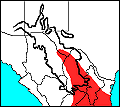


Mexican Long-nosed Bat in flight. Photograph courtesy of the U.S. Fish and Wildlife Service.
This bat prefers to live in a colonial setting, usually in a deep cavern. "The only known colony of these bats in the United States is found in a large cave on Mt. Emory in Big Bend National Park. The number of bats using the cave fluctuates widely from year to year with yearly estimates of population numbers ranging from zero to 13,650" (Davis and Schmidly 1994:33). The favorite habitat of this bat is the pine-oak mountainous country within a range of elevation from 5,000 to 7,500 feet; however, in the Big Bend area it may sometimes occur in agave and desert-scrub lowlands (Schmidly 1977). These bats visit Texas only from June to August and it appears that they plan their arrival in the state to coincide with the summer blooming cycle of agave plants (which provide nectar and pollen), then seldom wander far from these plants on which they depend (Tuttle 2003). This bat has recently been classified as endangered by the U.S. Fish and Wildlife Service (Davis and Schmidly 1994).
Davis, W. B., and D. J. Schmidly. 1994. The mammals of Texas. Texas Parks and Wildlife Press, Austin.
Schmidly, D.J. 1977. The mammals of Trans-Pecos Texas including Big Bend National Park and Guadalupe Mountains National Park. Texas A&M University Press. College Station.
Tuttle, M. D. 2003. Texas bats. Bat Conservation International, Inc., Austin.
§ The Mammals of Texas, Online Edition
A. Ruth Huckaby, Graduate Student, BIOL 5301-Natural History of the Chihuahuan Desert, June, 2006.
Huckaby Update: 22 June 2006
Last Update: 22 Jul 2009